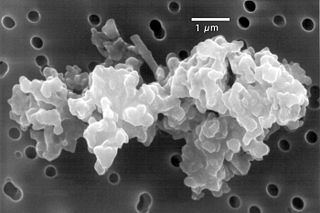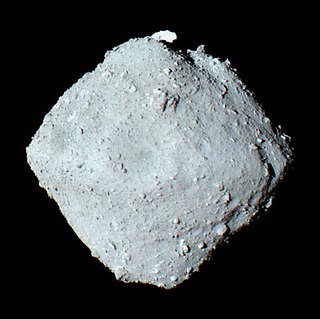
An asteroid is a minor planet of the inner Solar System. Sizes and shapes of asteroids vary significantly, ranging from 1-meter rocks to a dwarf planet almost 1000 km in diameter; they are rocky, metallic or icy bodies with no atmosphere.

25143 Itokawa (provisional designation 1998 SF36) is a sub-kilometer near-Earth object of the Apollo group and a potentially hazardous asteroid. It was discovered by the LINEAR program in 1998 and later named after Japanese rocket engineer Hideo Itokawa. The peanut-shaped S-type asteroid has a rotation period of 12.1 hours and measures approximately 330 meters (1,100 feet) in diameter. Due to its low density and high porosity, Itokawa is considered to be a rubble pile, consisting of numerous boulders of different sizes rather than of a single solid body.

Cosmic dust – also called extraterrestrial dust, space dust, or star dust – is dust that occurs in outer space or has fallen onto Earth. Most cosmic dust particles measure between a few molecules and 0.1 mm (100 μm), such as micrometeoroids. Larger particles are called meteoroids. Cosmic dust can be further distinguished by its astronomical location: intergalactic dust, interstellar dust, interplanetary dust, and circumplanetary dust. There are several methods to obtain space dust measurement.
Don Quijote is a past space mission concept that has been studied from 2005 until 2007 by the European Space Agency, and which would investigate the effects of crashing a spacecraft into an asteroid to test whether a spacecraft could successfully deflect an asteroid on a collision course with Earth. The orbiter was designed to last for seven years. The mission did not proceed beyond initial studies.
The New Frontiers program is a series of space exploration missions being conducted by NASA with the purpose of furthering the understanding of the Solar System. The program selects medium-class missions which can provide high science returns.

Hayabusa2 is an asteroid sample-return mission operated by the Japanese state space agency JAXA. It is a successor to the Hayabusa mission, which returned asteroid samples for the first time in June 2010. Hayabusa2 was launched on 3 December 2014 and rendezvoused in space with near-Earth asteroid 162173 Ryugu on 27 June 2018. It surveyed the asteroid for a year and a half and took samples. It left the asteroid in November 2019 and returned the samples to Earth on 5 December 2020 UTC. Its mission has now been extended through at least 2031, when it will rendezvous with the small, rapidly-rotating asteroid 1998 KY26.

PLAnetary Transits and Oscillations of stars (PLATO) is a space telescope under development by the European Space Agency for launch in 2026. The mission goals are to search for planetary transits across up to one million stars, and to discover and characterize rocky extrasolar planets around yellow dwarf stars, subgiant stars, and red dwarf stars. The emphasis of the mission is on Earth-like planets in the habitable zone around Sun-like stars where water can exist in a liquid state. It is the third medium-class mission in ESA's Cosmic Vision programme and is named after the influential Greek philosopher Plato. A secondary objective of the mission is to study stellar oscillations or seismic activity in stars to measure stellar masses and evolution and enable the precise characterization of the planet host star, including its age.

162173 Ryugu, provisional designation 1999 JU3, is a near-Earth object and a potentially hazardous asteroid of the Apollo group. It measures approximately 900 metres (3,000 ft) in diameter and is a dark object of the rare spectral type Cb, with qualities of both a C-type asteroid and a B-type asteroid. In June 2018, the Japanese spacecraft Hayabusa2 arrived at the asteroid. After making measurements and taking samples, Hayabusa2 left Ryugu for Earth in November 2019 and returned the sample capsule to Earth on 5 December 2020.

OSIRIS-REx is a NASA asteroid-study and sample-return mission. The mission's primary goal is to obtain a sample of at least 60 g (2.1 oz) from 101955 Bennu, a carbonaceous near-Earth asteroid, and return the sample to Earth for a detailed analysis. The material returned is expected to enable scientists to learn more about the formation and evolution of the Solar System, its initial stages of planet formation, and the source of organic compounds that led to the formation of life on Earth.

(175706) 1996 FG3 is a carbonaceous asteroid and binary system, classified as near-Earth object and potentially hazardous asteroid of the Apollo group, approximately 1.7 kilometers (1.1 miles) in diameter. The primary has a spheroidal shape. Its minor-planet moon measures approximately 490 meters (1,600 feet) in diameter.
Hayabusa Mk2 was a proposed Japan Aerospace Exploration Agency (JAXA) space mission aimed at visiting a small primitive asteroid and returning a sample to Earth for laboratory analysis. It was intended to be the follow-on mission to JAXA's Hayabusa mission, as well as the Hayabusa2 mission. The latest proposal for Hayabusa Mk2 stated its target to be the dormant comet 4015 Wilson–Harrington, with a launch of the probe in 2018. From 2007 to 2010, it was also considered as a joint JAXA-ESA mission under the name Marco Polo. The in-situ investigation and sample analysis would allow scientists to improve our knowledge of the physical and chemical properties of a small Near-Earth Object (NEO) which is thought to have kept the original composition of the solar nebula in which planet formed. Thus, it would provide some constraints to the models of planet formation and some information on how life may have been brought to Earth. Information on the physical structure will help defining efficient mitigation strategies against a potential threatening object.

Patrick Michel is a French planetary scientist, Senior Researcher at CNRS, leader of the team TOP of the Lagrange Laboratory at the Côte d'Azur Observatory in Nice (France).
OKEANOS was a proposed mission concept to Trojan asteroids, which share Jupiter's orbit, using a hybrid solar sail for propulsion; the sail was planned to be covered with thin solar panels to power an ion engine. In situ analysis of the collected samples would have been performed by either direct contact or using a lander carrying a high-resolution mass spectrometer. A sample-return to Earth was an option under study.

Explorer of Enceladus and Titan (E2T) is a space mission concept that would investigate the evolution and habitability of the Saturnian satellites Enceladus and Titan and is proposed by the European Space Agency in collaboration with NASA.
Castalia is a proposed mission concept for a robotic spacecraft to explore the main-belt comet 7968 Elst–Pizarro and make the first in situ measurements of water in the asteroid belt, and thus, help solve the mystery of the origin of Earth's water. The lead is Colin Snodgrass, from The Open University in UK.
ASTER is a planned space mission under development by the Brazilian Space Agency that will launch a spacecraft to orbit a near-Earth object known as (153591) 2001 SN263, a triple asteroid system. The launch is scheduled for 2025, with a rendezvous in 2024/2027.
Cosmic Vision is the third campaign of space science and space exploration missions in the Science Programme of the European Space Agency (ESA). Formulated in 2005 as Cosmic Vision: Space Science for Europe 2015–2025, the campaign succeeded the Horizon 2000 Plus campaign and envisioned a number of missions in the fields of astronomy and solar system exploration beyond 2015. Ten missions across four funding categories are planned to be launched under Cosmic Vision, with the first being CHEOPS in December 2019. A mission to the Galilean moons (JUICE), the first deep space mission with an opportunistic target, and one of the first gravitational-wave space observatories (LISA), are planned for launch as part of the Cosmic Vision campaign.

Stephan Ulamec is an Austrian geophysicist, from Salzburg, with more than 100 articles in peer-reviewed journals and several participations in space missions and payloads operated by diverse space agencies. He is working at the German Aerospace Center in Cologne. He is regularly giving lectures about his publications in aerospace engineering at the University of Applied Sciences: Fachhochschule FH-Aachen. Main aspects of his work are related to the exploration of small bodies in the solar system.














